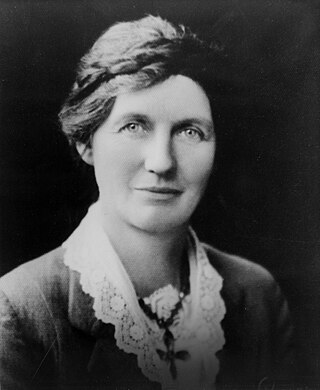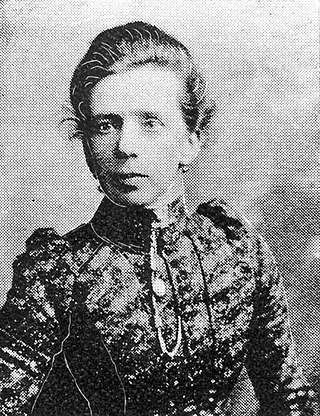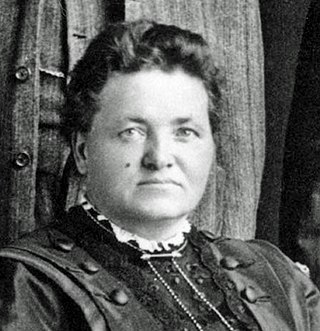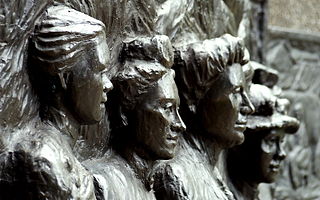
Katherine Wilson Sheppard was the most prominent member of the women's suffrage movement in New Zealand and the country's most famous suffragist. Born in Liverpool, England, she emigrated to New Zealand with her family in 1868. There she became an active member of various religious and social organisations, including the Women's Christian Temperance Union New Zealand. In 1887 she was appointed the WCTU NZ's National Superintendent for Franchise and Legislation, a position she used to advance the cause of women's suffrage in New Zealand.

Elizabeth Reid McCombs was a New Zealand politician of the Labour Party who in 1933 became the first woman elected to the New Zealand Parliament. New Zealand women gained the right to vote in 1893, though were not allowed to stand for the House of Representatives until the election of 1919. McCombs had previously contested elections in 1928 and 1931.

The Christchurch Botanic Gardens, located in the central city of Christchurch, New Zealand, were founded in 1863 when an English oak was planted to commemorate the solemnisation of the marriage of Prince Albert and Princess Alexandra of Denmark. The gardens sprawl over an area of 21 hectares and lie adjacent to the loop of the Avon River next to Hagley Park. The Christchurch Botanic Gardens have a variety of collections of exotic and local plants of New Zealand, several conservatories, a nursery, playground and Climatological Station.

The 1893 New Zealand general election was held on 28 November and 20 December in the European and Māori electorates, respectively, to elect 74 MPs to the 12th session of the New Zealand Parliament. The election was won by the Liberal Party, and Richard Seddon became prime minister.

Women's suffrage was an important political issue in the late-nineteenth-century New Zealand. In early colonial New Zealand, as in European societies, women were excluded from any involvement in politics. Public opinion began to change in the latter half of the nineteenth century and after years of effort by women's suffrage campaigners, led by Kate Sheppard, New Zealand became the first nation in the world in which all women had the right to vote in parliamentary elections.

Alfred Saunders was a New Zealand farmer, reformer, women's suffrage and temperance advocate and politician. He was Superintendent of Nelson Province and represented several electorate in the House of Representatives.

John Joseph Dougall was Mayor of Christchurch in 1911–1912. He was a solicitor by profession. In his later life, the Navy League was his main interest.

Ada Wells was an English-born New Zealand feminist and social worker.

Helen Lyster Nicol was a New Zealand suffragist and temperance campaigner. She is one of six suffragists honoured in the Kate Sheppard National Memorial.
Margaret Home Sievwright was a New Zealand feminist, political activist and community leader. She was particularly active in the temperance and suffrage movements, and became president of the National Council of Women of New Zealand.

Lucy Masey Lovell-Smith was a notable New Zealand editor, feminist, temperance and welfare worker. She wrote under the pen-name "Vesta" when contributing to newspapers about women's rights. In 1926, she changed her surname to Lovell-Smith.

Harriet Russell Morison was a New Zealand tailor, trade unionist, suffragist and public servant.

Katherine Christian Beath was probably the first female architect in New Zealand.

The Odeon Theatre in Christchurch was the oldest masonry theatre in New Zealand, and one of only three remaining purpose-built 19th-century theatres in the country. The building has had different names over the years, and was put to many different uses. It was damaged beyond repair in the 22 February 2011 Christchurch earthquake and partially demolished in September 2012. The theatre was recognised as a Category I heritage building by the New Zealand Historic Places Trust, with registration number 3140. One of its most notable aspects was its use as a public meeting venue of Kate Sheppard during her women's suffrage campaign.

The Kate Sheppard National Memorial, located in the city of Christchurch, is New Zealand's first memorial to the women's suffrage campaign, and particularly honours the life of one of the country's leading campaigners for women's suffrage, Kate Sheppard.

The Kate Sheppard Memorial Trust Award is an award made annually on September 19, known as Suffrage Day, in New Zealand. This day is the anniversary of women winning the right to vote in New Zealand in 1893.

The Kate Sheppard Cup, currently known as the New Zealand Football Foundation Kate Sheppard Cup for sponsorship purposes, is New Zealand's premier knockout tournament in women's association football. Founded in 1994, it was known as the Women's Knockout Cup, until it was renamed in 2018. What would have been the 2020 edition of the competition, was cancelled because of COVID-19 but the competition continued again in 2021.
Eleanor Phoebe Smith was a New Zealand suffragist and magazine editor. She was considered one of the pioneers of the woman suffrage movement in New Zealand.

Women's Christian Temperance Union of New Zealand is a non-partisan, non-denominational, and non-profit organisation that is the oldest continuously active national organisation of women in New Zealand. The national organisation began in 1885 during the visit to New Zealand by Mary Clement Leavitt, the first world missionary for the Woman's Christian Temperance Union. The WCTU NZ was an early branch of the World Woman's Christian Temperance Union and a founding affiliate of the National Council of Women of New Zealand. Men may join the WCTU NZ as honorary members.




















